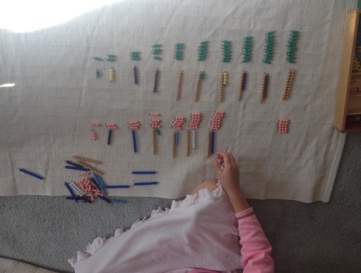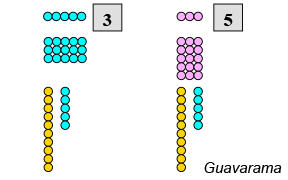Age: 7.5
Presentations: Multiples: Concept and Language of Multiples, Multiples: Common Multiples, Commutative Law of Multiplication: A Number x a Number, Commutative Law of Multiplication: A Sum x a Number
Last week, I did 3-4 math presentations related to multiplication. I believe this is called 現買現賣 in Chinese. I basically practiced on Thumper what I’d learned in class. Partly because my teacher said these presentations should be done as soon as possible in Elementary, maybe the first few weeks/months of school?
I skipped the Wooden Hierarchical Material because I just don’t have time to make the material and while Thumper needs a review and could really use the visual, she’s been exposed to the concept already. Instead, we did the following presentations:
- Multiples: Concept and Language of Multiples
- Multiples: Common Multiples
- Commutative Law of Multiplication: A Number x a Number
- Commutative Law of Multiplication: A Sum x a Number
These four are just part of two different write-ups. But it seems that these are the most basic ones that can be grouped together because they require no writing from the child whatsoever. After what my teacher said about working with the math manipulatives without writing, I’m now not as confused about what I’m supposed to be doing with these presentations. As I dive into the materials, I can see that these same concepts in multiplication are reviewed over and over again, each time getting more abstract, so I don’t need to stay with work with one material for too long if it seems like Thumper gets it. I would know she doesn’t get it when she’s stuck at understanding how to use a material. For this reason, I did not “make” her to take out the beads again and try it herself at a later date after she said she wasn’t interested.
Multiples
The Language of Multiples presentations are about defining what a multiple is. Like, 2,4,6,8. You lay out the short bead chains, label them, skip count for the experience and then give a definition. This lesson took Thumper all of 5 minutes. Astroboy was the one who actually counted for her and laid the number labels down on the rug, since he likes to count.
I laid out the short bead chains, have the child label them, and for each number say something like, “有幾個5在10裏面?(How many 5s are in 10. 剛剛好有兩個五在十裏面,而且沒有剩下。(There are exactly 2 5s in 10 with nothing left over)…..二十五是五的倍數 (25 is a multiple of 5)” After repeating the “nothing left over a few times” (沒有剩下), Thumper suddenly interjected and said, “Oh! What about the other numbers, do they have something left over?” And she proceeded to try it out by skip counting numbers 4, 3, 2, 1 using the bead chain of 5 while I continued working with Astroboy in counting and labeling his bead chain of 6. Thumper determined that for all numbers except 1, 25 is not their multiple. I really liked this aha moment for her and I think is one of the strong arguments for using manipulatives.
I will make sure to say “nothing left over” as well taking about multiples in other lessons now. I do want to note how it does not roll off my tongue translating the album and saying it in Chinese. It is obviously not a daily conversation I hold with people.

In the Common Multiples presentation you lay out a bunch of bead bars. The kids find for themselves multiples that are common to each number. For example, in the photo, she is laying out the multiples of 2 and 3 in a multiplication table format, then laying out the answer using your decanomial bead bars (bead bars #1-#10), then looking for all the common ones they have. (6, 12, etc). I’m finding that Thumper still has a liking to moving beads around. She got the concept pretty quick since she knows some of her multiplication tables.

Sorry I don’t have photos for the rest. I will show you my album pics instead.
Commutative Laws of Multiplication
The Commutative Laws ones shows multiplication rule that it doesn’t matter what order you put the numbers in:
- a x b = b x a
- (a + b) x c = c x (a + b)

In this exercise, you lay out the multiplicand (被乘數) in bead bars horizontally, the multiplier (乘數)using a gray card, then you calculate, exchanging and laying the product out vertically. You do the same thing in reverse to show that the answers are the same. And my favorite part is the teacher saying, “I wonder if this will work with other numbers?” I like the invitation to exploration rather than telling the child about the property and that’s it.

Thumper really lingered on the last presentation (A Sum x a Number). We must have spent more than an hour on this. She just kept pulling out numbers to try even though she kind of understood the concept already after the presentation. Similar to the previous one, you’re using bead bars for the multiplier and gray cards for the multiplicand. And just showing that the products are the same. (a + b) x c = c x (a + b)
Even when Astroboy and I went upstairs to have lunch she was still figuring them out. I loved that she found the topic interesting. I couldn’t help myself (I know I know) and told her that there is a secret in the work. I wanted her to figure out that you can add the two numbers together in order to get the sum and then multiply them by the multiplier.
It was really neat to watch how her brain is working out new knowledge. After the first presentation she knew that the answers are the same. But she still wanted to figure out the answer each time for each side. I’m not sure why that is. She got really busy making her own multiplication tables, using the Chinese version of Nienhuis-like multiplication table sheets I made for her 3 months ago. It was so she can look up the answer instead of calculating in her head each time. I didn’t ask her to do that. And in hindsight I could have pointed her to the multiplication chart, which is a Montessori material. But I just let her explore as she wanted.
She did figure out the secret to the “presentation”; that you can add the numbers together first. Though this week I found out that you don’t really want them to figure this out because your’e teaching commutative law. oops!)
If I go with what my teacher said, I would probably just ask her next week during our planning session to see if she wants to try working them again without me. We are obviously a bit in this presentation, but it was still fun for Thumper. I think you can start this at 6+, depending on what the child knows.
All in all a really good week on the math front. Really glad I decided to splurge and take that math class.
Multiples in Chinese
Here are the vocabulary I needed to look up in order to present. Chinese is much easier to understand new math terms because I don’t have to know Latin.
- Multiples – 倍數
- Common Multiples – 公倍數
- Multiplier – 乘數
- Multiplicand – 被乘數 (literally means the number being multiplied)